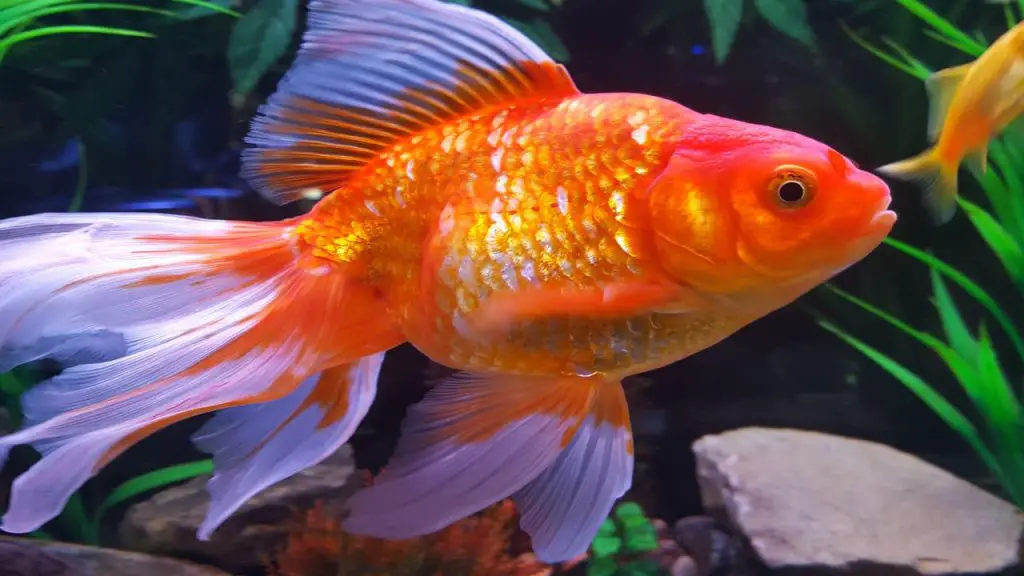Goldfish are a type of fish that live in freshwater and are often kept as pets in aquariums. They are well-known for their bright colors and distinctive patterns, making them popular among people new to owning fish.
One of the reasons why goldfish are so popular is because they are relatively easy to take care of. With the proper care and attention, goldfish can live for several years.
In this article, we will explain the appropriate ways to care for your goldfish. So, let’s start by examining the common types of goldfish that are commonly kept as pets.

1. Types of goldfish people keep as pets
In the following paragraph, we will talk about different kinds of goldfish that people usually have as pets in fish tanks.
But it’s important that each type of goldfish has its own physical characteristics and traits that you should consider when choosing the right goldfish for your specific needs.
Some of these types do better in indoor aquariums, while others may be better suited for outdoor ponds.
So let’s dive into the different types of goldfish and find the perfect one for your need.
- Common Goldfish: This is the most basic type of goldfish and is often the one people first think of when they hear “goldfish”. They have long, slender bodies and can grow up to 12 inches long. Common goldfishes are typically bright orange or gold in color, with a few black spots on their scales.
- Comet Goldfish: Comet goldfish are similar in appearance to the common goldfish, but with a longer, more streamlined body and a longer, more deeply forked tail. They tend to be orange or red in color, with a few white or yellow markings on their scales.
- Shubunkin Goldfish: This type of goldfish has a calico pattern of blue, orange, and black on its scales. Slender bodies and forked tails of these types of goldfish can grow up to 10 inches long.
- Fantail Goldfish: These fish have a rounded body and a double tail that looks like a veil. Fantail goldfish are typically orange or red, but can also be black, blue, or white.
- Ryukin Goldfish: This type of goldfish has a hump on its back and a rounded body with a double tail. Ryukin Goldfish come in a variety of colors, including red, orange, white, and black.
- Oranda Goldfish: These fish have a rounded body and a cap-like growth on their head called a wen. Oranda goldfish come in various colors and can grow up to 8 inches long.
- Black Moor Goldfish: Black Moor Goldfish have rounded bodies and protruding eyes that appear distinctive. They are typically black but can also be orange or gold.
- Bubble Eye Goldfish: These fish have fluid-filled sacs under their eyes that give them a unique appearance. Bubble Eye Goldfish have a rounded body and a double tail and come in various colors.
- Lionhead Goldfish: Lionhead Goldfish have a rounded body and a wen on their head that resembles a lion’s mane. They come in various colors and can grow up to 6 inches long.
- Telescope Goldfish: These fish have protruding eyes that give them a telescope-like appearance. Telescope Goldfish has a rounded body and a double tail and come in various colors.
2. How To Take Care Of Goldfish?
Let’s divide this section into two parts to discuss the care of goldfish in indoor and outdoor environments separately.
We’ll look at the important factors for each environment such as water quality, feeding, temperature regulation, and observation to ensure the well-being of your goldfish.
2.1 Indoor care guide
To properly take care of your indoor goldfish, you need to provide them with a suitable environment, feed them the right food, and maintain their tank correctly.
Goldfish tank and water quality: When it comes to goldfish, they need a spacious environment to swim around and thrive in.
Therefore, it’s recommended to have a tank that can hold at least 20 gallons of water for one goldfish, and for each additional goldfish, you should add another 10 gallons of water to the tank.
This way, your goldfish will have ample space to move around and explore. Moreover, goldfish produce a lot of waste, which means that you need to make sure the tank has a proper filtration system to keep the water clean.
A high-quality filter should be able to filter the entire volume of the tank at least four times per hour to ensure that the water quality stays optimal for your goldfish.
In addition to filtration, you should also clean the tank regularly by replacing a portion of the water (10-20%) every week.
This will help maintain good water quality, remove any accumulated waste, and prevent the buildup of harmful toxins that can negatively affect your goldfish’s health.
By providing your goldfish with a spacious tank and ensuring the water is clean, you’re creating an ideal environment for them to live in and thrive.
Feeding goldfish: It’s important to keep in mind that these aquatic creatures are omnivores, which means that they require a balanced diet consisting of both plant and animal matter.
In order to meet their dietary needs, goldfish should be fed a varied diet that includes specialized flakes or pellets specifically formulated for their nutritional requirements.
Goldfish derive pleasure from consuming live or frozen foods such as brine shrimp, bloodworms, and daphnia in addition to their regular diet.
These foods can be particularly advantageous for goldfish as they offer essential nutrients and proteins that may be missing in their staple foods.
When feeding goldfish, it’s important to avoid overfeeding as this can lead to health problems like constipation and obesity.
It’s recommended to feed goldfish small amounts of food several times a day, rather than one large meal.
By offering a well-balanced and diverse diet, you can promote the enduring well-being and joy of your goldfish for many years ahead.
Temperature: Goldfish are sensitive to water temperature changes, and keeping their environment stable is essential to their health and well-being. Maintaining the water temperature between 65-75°F (18-24°C) is optimal for goldfish to thrive.
A thermometer can help you keep track of the water temperature and identify any fluctuations. A heater can be used to regulate the temperature and keep it within the ideal range.
However, it’s essential to avoid sudden temperature changes, as they can cause stress to your goldfish and make them more susceptible to diseases. Maintaining a consistent temperature throughout the day and night, regardless of the weather or season, is crucial to your goldfish’s health.
Observation: Observing your goldfish regularly is crucial for their overall health and well-being. Just like humans, goldfish can fall sick and display symptoms that require immediate attention.
As a responsible pet owner, it’s important to keep an eye out for any unusual behavior or signs of illness, such as lethargy, loss of appetite, or white spots on the body.
Regularly observing your goldfish can help detect any potential health issues before they worsen, which can save your fish’s life and prevent the spread of illness to other fish in the tank.
If you notice anything unusual or concerning, it’s essential to consult a veterinarian who specializes in fish.
They can provide the appropriate treatment and care needed to diagnose and treat a wide range of fish-related health issues, ensuring your goldfish’s prompt recovery and overall well-being.
2.2 Outdoor care guide
Keeping goldfish in outdoor ponds can be a great option as they make wonderful pets. But there are some important things to keep in mind to make sure that they stay healthy and happy in their new environment.
You should continue to maintain good water quality, provide the right food, observe your fish regularly, and keep the temperature suitable, just like you would for indoor goldfish care.
Additionally, you can add plants, rocks, and other decorations to the pond to give them hiding places and make them feel more secure. To maintain a comfortable temperature and protect your fish from the sun, you can use a heater or shade cover.
Conclusion
Thus in this blog post, we have discussed different types of goldfish and provided guidance on how to take care of them both indoors and outdoors.
We hope this information has been helpful to you and thank you for taking the time to read my article.
FAQ’s
Can goldfish live with other fish?
Goldfish are social and can live with other goldfish or fish species that tolerate similar water conditions. However, avoid keeping them with aggressive fish or smaller species that could be seen as prey.
How long do goldfish typically live?
Goldfish can live up to 20 years or more with proper care.
How can I make my goldfish tank look more attractive?
Adding live plants, decorations, and substrate can help make your goldfish tank more visually appealing. Just make sure any items added are safe and do not pose a hazard to your fish.
Additional Posts:



